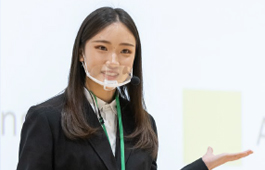
趙 梓瀛 Zhao Zi Ying
名古屋外国語大学 世界教養学部 3年
Good afternoon, everyone. I have a question for you. Do you think fake news has become a serious problem these days?
This is one of the questions in my survey that I asked 100 people each from Japan and America. These people are all in their 20th and finished their compulsory education.
Let’s take a look at the results.
If you look at these pie charts, you will immediately find out the clear difference between these two countries.
The biggest segment of the American pie chart is the percentage of people who strongly agree and agree. On the other hand, it is obvious that more people in Japan don’t seem to care about this problem.
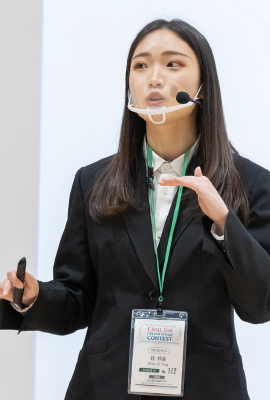
Why is that? One of the reasons for this is because news literacy is still not widely known in Japan.
While FactCheck, Checkology and many more projects have already been playing a big role in news literacy education in Western countries, Japan is pretty much behind in news literacy education, which leads us to have low awareness of this serious social problem that we have right now.
And lots of us don’t realize or didn’t know the fact that fake news has always been around us until the rise of social media has been causing rapid spreading of fake news.
So how can we improve this situation?
Today, I’d like to present fun educational program to improve the news literacy project mostly for children, which is using educational comics in other word, using “Online News Literacy Comic”.
For today’s presentation, first, I’ll talk about what is Online News Literacy Comic and second, where and how let children to use it.
First, I’ll start by explaining how exactly some of the advantages of educational comics can be connected to the contents of news literacy comics.
This Online News Literacy Comic can be divided into 2 parts. Basic information and history.
Not only inputting information by reading, but also each topic includes question games and a comment section where you can output what you’ve learnt and check your understanding.
Basic information teaches readers basic or specific words and information for news literacy.
This sounds like textbooks, but comics are structured in a way that makes it fun for kids to learn while the visual cues can help children decode unfamiliar vocabulary and memorize them quickly according to the study.
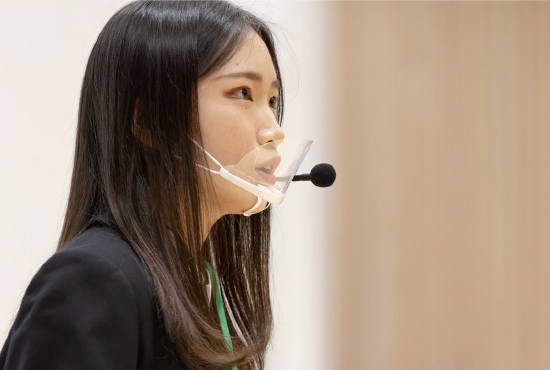
For example, one of the most important things we must know is the system that provides us information.
Where does the information come from? How do newsrooms work?
But not all the schools can make an opportunity to take students to go on the newsroom trip or invite journalists to have a talk show.
However, comics can take you anywhere which is also one of the advantages educational comics have.
I visited my elementary school library to see if I could find any educational comics about it and I actually found them among more than 500 educational comic books, but as you see, they look very old, so they definitely need to be updated.
I also found out how much students love to read educational comics especially about history, which is the content that Online News Literacy Comic has as well.
The second part of the contents which I think is the most important, is history.
Like I mentioned in the beginning, if we don’t know the damages that caused by fake news, we also don’t know how serious the problem is and how our real life can be affected.
To raise our awareness of this problem, we must learn from the consequences of fake news in the past.
A combination of images and text let children make inferences and synthesize information. Moreover, visual storytelling makes it easier to imagine and see yourself in the story.
Now I’d like to show you an example, since it’s just an example, I made it brief and very short.
Please imagine you’re a junior high school student.
The story is about fake ‘lion on the loose’ tweet after earthquake.
On April 14, year 2016 at around 10 p.m., huge earthquake occurred in Kumamoto.
About 30 minutes after the quake, picture of lion walking on the street with a message says “Kumamoto, there’s a lion on the loose near my house because of the earthquake.” was posted.
The tweet was retweeted at least 20,000 times in an hour. So, who and why do you think post this? The 20-year-old man who was a resident of Kanagawa Prefecture posted the tweet with no other purpose, but he just wanted to shock people who saw the tweet.
And what do you think happened next?
This man was arrested for fraudulent obstruction of business.
The Kumamoto Zoo and Botanical Gardens received more than 100 phone inquiries from frightened residents.
I hope you got an idea of why sharing this kind of stories is important.
You or anyone could’ve been this man or one of the victims of this fake tweet.
Now you realized the consequences of fake news can be more serious than you could’ve ever imagine. At the end of each story, there’re question games and a comment section where you can discuss it with other users.
Next, I’d like to talk about usage of this Online News Literacy Comic to teach children at school in Japan. My idea is to introduce this Online News Literacy Comic to the ICT support system.
The Ministry of Education set a goal to have at least one ICT support staff who is in charge of 4 elementary or junior high schools by 2022. These staff are responsible for maintenance ICT education environment and assisting teachers and students with the ICT education program which of course includes media literacy.
So why not use this Online News Literacy Comic as one of the materials of teaching students about media and news literacy.
I interviewed my junior high school math teacher who is responsible for the ICT program so far. He claimed that as much as they would love to give a proper literacy education, but the reality is, all teachers have a tight schedule 24/7 so it’s almost impossible to take care of extra classes.
The teacher loved my idea and I also believe this is quite realistic way to provide media & news literacy education at school since e-learning is a part of Japanese education now.
To end my presentation, I will sum up our main points.
Educational comics can help children’s reading comprehension such as understanding unfamiliar vocabulary and contents. It makes it possible to get children interested in the topic even if they’re not really willing to learn.
It is also effective to make children imagine themselves in the story so that they’ll get the seriousness of the matter.
Question games will train their way of handling all this information on the web.
Lastly, incorporating the use of this Online News Literacy Comic into ICT support system so that teachers don’t have to carry an extra burden.
Look, I want all children to be aware of the seriousness of this social problem caused by lack of news literacy. I want all children to be interested in this topic, think deeply about it, talk about it with friends, and become a better information sender to build a better web world.
I believe that this Online News Literacy Comic can give a fun and proper education to all children who are going to be thrown into a flood of information in their near future so that they will make the right decision to stand up for truth.
Thank you very much.
みなさんこんにちは。みなさんに質問があります。最近、フェイニュースは深刻な問題になっているとみなさんはお考えでしょうか?
これは私の調査で、日本人100人、アメリカ人100人に投げかけた質問のひとつです。対象の人々はみな20代で、義務教育を終えています。
結果を見てみましょう。
円グラフを見ると、両国間での明らかな違いにすぐ気づくことでしょう。
アメリカ人の円グラフでは、「強く同意する」と「同意する」が一番大きい領域を占めています。一方で、日本人の多くの人々がこの問題についてあまり問題視していないことは明らかです。
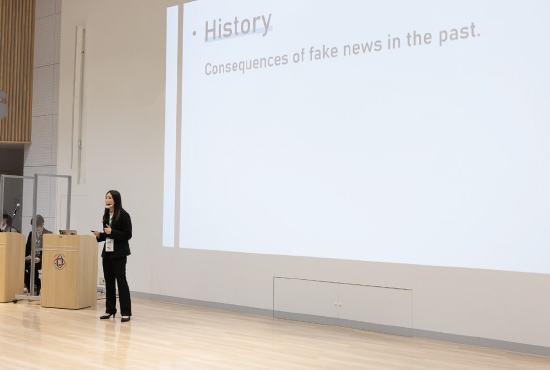
なぜでしょうか? その理由のひとつは、日本ではニュースリテラシーがあまり広く知られていないことが挙げられます。
欧米諸国では、ファクトチェック(FactCheck)やチェクロジー(Checkology)など多くのプロジェクトがすでにニュースリテラシー教育で大きな役割を占めています。一方、日本では、ニュースリテラシー教育はかなり遅れており、現在私たちが抱えている深刻な社会問題に対する意識の低さをもたらしているのです。
そして、私たちの多くは、ソーシャルメディアの隆盛によってフェイクニュースを急速に広まるまで、身の回りにあるフェイクニュースがあることを認識してこなかったし、知りませんでした。
では、どうすればこの状況を改善できるのでしょうか?
本日、私は子どもたちがニュースリテラーのプロジェクトを改善するための楽しい教育プログラムをプレゼンテーションします。これは教育的な漫画である、「オンラインニュースリテラシー漫画」を使うものです。
本日のプレゼーションでは、最初にオンラインニュースリテラシー漫画とは何かを説明し、次にどこで、どのようにこれを使うかを紹介します。
まず、いかに教育的な漫画とニュースリテラシー漫画の内容を関連づけることで得られるいくつかの利点を詳しく説明することから始めます。
オンラインニュースリテラシー漫画は主に2つのパートに分けることができます。基本情報と歴史です。
単に読解によって情報をインプットするだけでなく、それぞれのトピックには質問ゲームとコメントの欄があり、生徒は自分が学んだことをアプトプットし、理解したことを確認できます。
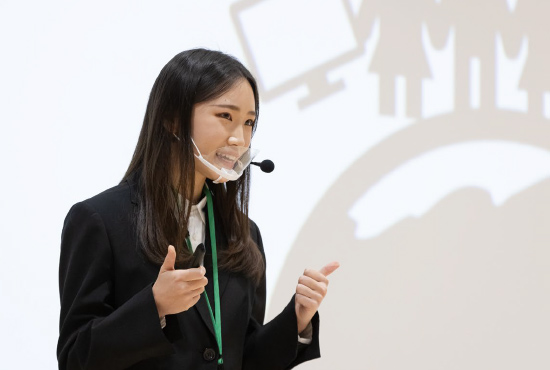
基本情報では、読者はニュースリテラシーに関する基本的もしくは専門的な用語を学ぶことができます。
まるで教科書のように聞こえますが、漫画は子どもが楽しんで学べる構成になっており、可視化された手がかりによって子どもたちは耳慣れない言葉を解読し、勉強をしながらすぐに覚えることができるのです。
例えば、私たちが知るべき最も重要な事項に、情報を提供するシステムがあります。
その情報はどこから来たのか? ニュースの編集室はどのように機能しているのか?
しかし、すべての学校が生徒たちをニュースの編集室へと連れて行けるわけではありませんし、ジャーナリストを呼んで講演をしてもらえるわけでもありません。
しかしながら、漫画は子どもたちをどこにでも連れていけるし、それこそが教育的な漫画の利点であるのです。 私は母校の小学校を訪れ、ニュースリテラシーに関する教育的漫画があるかを調べました。すると、図書館には500冊以上の教育的な漫画がありましたが、この通り、とても古く、明らかに情報のアップデートが必要でした。
同時に、私は小学生たちが教育的な漫画、とりわけ歴史に関しての漫画を読むのが大好きであることを知りました。だからこそ、オンラインニュースリテラシー漫画が有効なのです。
コンテンツの2つめのパートは歴史であり、私はこれが最も重要だと考えています。
冒頭で説明した通り、もし私たちがフェイクニュースで生じる損害について知らなければ、この問題がいかに深刻なものであり、実生活にどんな影響を与えるかも理解できません。
この問題に関する意識を向上させるため、私たちは過去においてフェイクニュースが生じた結果を学ぶ必要があります。
画像と文字の組み合わせによって、子どもたちは情報を推測し、統合することができます。さらに言えば、視覚的な物語は想像の助けとなり、自らを物語に没入できるのです。
例を挙げましょう。単なる例です。簡潔で短いものです。
あなたは中学生だとイメージしてください。
地震の後、「ライオンが逃亡した」というフェイクのツイートに関する話です。
2016年4月14日午後10時ごろ、熊本で大地震が起きました。
地震のおよそ30分後、通りをライオンが歩いている写真がそこには「熊本、地震によって、私の家の近くに逃亡したライオンがいる」というメッセージとともに投稿されました。
このツイートは1時間で、2万回もリツイートされました。だれが、そしれなぜ、このような投稿がされたとみなさんはお考えでしょうか? 神奈川県に住む20歳の男性がこのツイートを投稿しました。彼の目的は、ツイートを見た人々を驚かせたいと以外のなにものでもありませんでした。
では、何が起きたと思いますか?
この男性は業務妨害で逮捕されました。
熊本市動植物園は、恐怖を感じた住民から100件以上の電話を受けました。
こういった話を共有することの重要性をみなさんご理解できたことでしょう。
みなさんは、そして誰もが、この男性にもなりえるし、フェイクツイートの犠牲者にもなりえるのです。
ここで読者は、フェイクニュースは想像していたよりも深刻な結果を招くことを認識しました。それぞれの話の最後では、質問ゲームとコメントのセクションで、他の読者と議論することができます。
次に、日本の学校において、オンラインニュースリテラシー漫画の活用方法についてお話をします。私のアイデアはICTサポートシステムにオンラインニュースリテラシー漫画を導入することです。
文部科学省は、2022年までに小学校もしくは中学校の4校ごとに担当のICTの支援スタッフを1人配置する目標を掲げています。支援職員は、学校のICT教育環境の維持管理および、ICT教育プログラムに関して教員と生徒を補助する役割を担っています。このプログラムには、メディアリテラシーが含まれています。
では、メディアリテラシーやニュースリテラシーを生徒に教える教材として、このオンラインニュースリテラシー漫画を使えるのではないでしょうか。
私は母校の中学校で数学の先生にインタビューをしました。先生はこれまでICTプログラムの担当をしてきました。彼は、ぜひ適切なリテラシー教育を可能な限りしたいが、現実には、すべての先生はとても忙しくて休みもない状態であり、これ以上、授業を増やすのはほとんど不可能であると述べています。
この先生は私のアイデアを大変気に入ってくれました。私もまた、この提案がメディアやニュースのリテラシーの教育を提供するとても現実的な方法であることを確信しました。学校においてeラーニングが日本の教育のひとつになりつつある今だからこそです。
プレゼンテーションの最後に、要点のまとめをします。
教育的な漫画は、子どもたちが耳慣れない言葉や内容を理解するうえでの読解に役立ちます。たとえ、あまり学びたくないと思っているトピックでも、子どもたちに関心を抱かせることも可能です。
また、教育的な漫画には子どもたちが物語に没入できる効果があるので、事態がいかに深刻であるかも理解できます。
質問ゲームによって、こういった情報をいかに取り扱うべきかをウェブ上で鍛えることができます。
そして最後に、オンラインニュースリテラシー漫画とICUサポートシステムが協力することによって、教員にさらなる負担を課す必要もありません。
私は、すべての子どもたちに、ニュースリテラシーの欠如によって生じているこの社会問題の深刻さに気づいてほしいのです。すべての子どもたちがこのトピックスに興味を持ち、深く考え、友だちと話し、よりよきウェブ世界を構築するための、良き情報の送り手になってほしいのです。
私は、このオンラインニュースリテラシー漫画が楽しさとともに、近い将来に情報の洪水に投げ込まれても、真実を守る正しい判断が下せるようになれるよう、適切な教育をすべての子どもたちに与えられると信じています。
ありがとうございました。